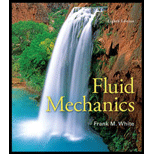
Concept explainers
To rewrite:
Dimensionless function and To plot:
Using the pi theorem and plot the given data in dimensionless form.
Answer to Problem 5.4CP
The dimensionless function is
Explanation of Solution
Given Information:
The Taco Inc. model 4013 centrifugal pump has an impeller of diameter D = 12.95 in. The measured flow rate Q and pressure rise

Concept Used:
The number of pi groups are to be calculated:
Where k is the number of variables and r is the number of fundamental references.
On substituting 5 for k and 3 for r ,
According to tables, the density of water at 20°C is
Calculation:
Dimensional analysis is applied to find the pi groups.
First pi group:
Where
On substituting
On equating M coefficients:
On equating T coefficients:
On equating L coefficients:
Hence, a = 0, b = -3 and c = -1
Therefore, the first pi group is as follows:
Second pi group:
Where
On substituting
On equating M coefficients:
On equating T coefficients:
On equating L coefficients:
Hence, a=- 1, b = -2 and c = -2
Therefore, the second pi group is as follows:
Hence the choices are
On substituting
Hence the dimensionless function is
The units of angular velocity are converted from r/min to rev/s.
=19.33 rev/s
The units of diameter are converted into feet:
=1.079 ft
The flow rate in ft3 /s is calculated:
The pressure in
The
On substituting
The
On substituting
=6.14
The values for pi groups at different values are calculated which are as follows:
| Q(gal/min) | |
|
| 200 | 0.0183 | 6.14 |
| 300 | 0.0275 | 5.97 |
| 400 | 0.0367 | 5.8 |
| 500 | 0.0458 | 5.46 |
| 600 | 0.0550 | 4.95 |
| 700 | 0.0642 | 3.92 |
Hence, the plot between

Conclusion:
The dimensionless function is
To estimate:
The pressure rise
Answer to Problem 5.4CP
The pressure rise
Explanation of Solution
Given Information:
The Taco Inc. model 4013 centrifugal pump has an impeller of diameter D = 12.95 in. The measured flow rate Q and pressure rise

A pump running at 900 r/min is used to pump 20°C gasoline at 400 gal/min.
Concept Used:
The units of angular velocity are converted from r/min to rev/s.
=15 rev/s
The flow rate in ft3 /s is calculated:
According to the tables, the density of gasoline at 20°C is
Calculation:
The
On substituting
=0.0473
According to the plot, for
The
On substituting 5.4 for
Conclusion:
The pressure rise
Want to see more full solutions like this?
Chapter 5 Solutions
Fluid Mechanics
 Elements Of ElectromagneticsMechanical EngineeringISBN:9780190698614Author:Sadiku, Matthew N. O.Publisher:Oxford University Press
Elements Of ElectromagneticsMechanical EngineeringISBN:9780190698614Author:Sadiku, Matthew N. O.Publisher:Oxford University Press Mechanics of Materials (10th Edition)Mechanical EngineeringISBN:9780134319650Author:Russell C. HibbelerPublisher:PEARSON
Mechanics of Materials (10th Edition)Mechanical EngineeringISBN:9780134319650Author:Russell C. HibbelerPublisher:PEARSON Thermodynamics: An Engineering ApproachMechanical EngineeringISBN:9781259822674Author:Yunus A. Cengel Dr., Michael A. BolesPublisher:McGraw-Hill Education
Thermodynamics: An Engineering ApproachMechanical EngineeringISBN:9781259822674Author:Yunus A. Cengel Dr., Michael A. BolesPublisher:McGraw-Hill Education Control Systems EngineeringMechanical EngineeringISBN:9781118170519Author:Norman S. NisePublisher:WILEY
Control Systems EngineeringMechanical EngineeringISBN:9781118170519Author:Norman S. NisePublisher:WILEY Mechanics of Materials (MindTap Course List)Mechanical EngineeringISBN:9781337093347Author:Barry J. Goodno, James M. GerePublisher:Cengage Learning
Mechanics of Materials (MindTap Course List)Mechanical EngineeringISBN:9781337093347Author:Barry J. Goodno, James M. GerePublisher:Cengage Learning Engineering Mechanics: StaticsMechanical EngineeringISBN:9781118807330Author:James L. Meriam, L. G. Kraige, J. N. BoltonPublisher:WILEY
Engineering Mechanics: StaticsMechanical EngineeringISBN:9781118807330Author:James L. Meriam, L. G. Kraige, J. N. BoltonPublisher:WILEY





